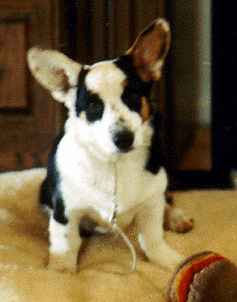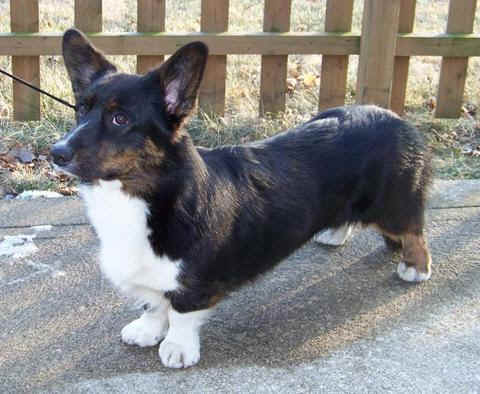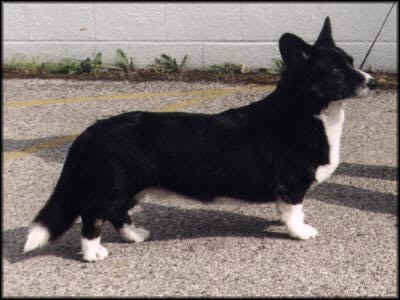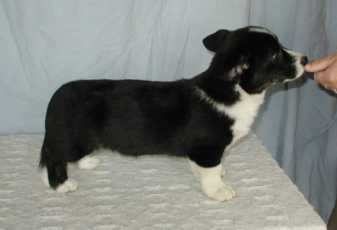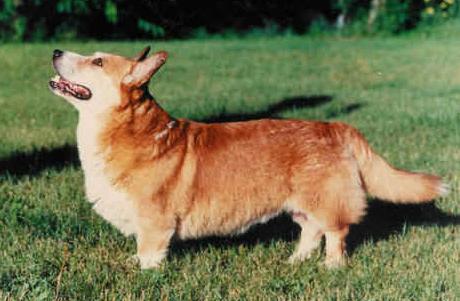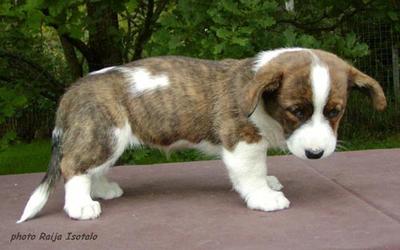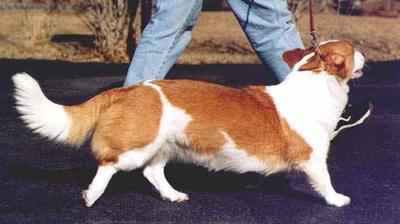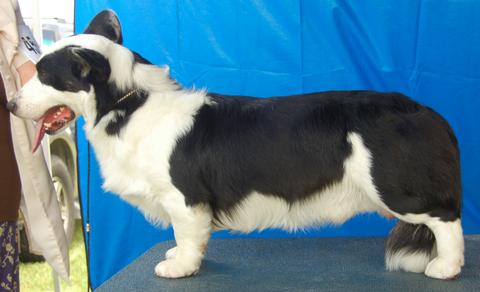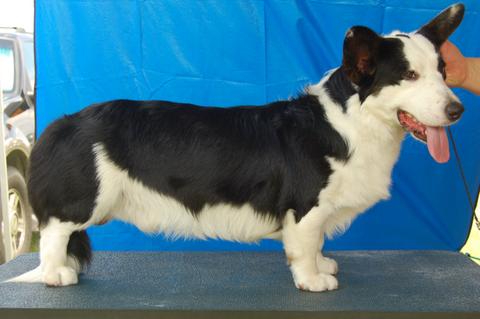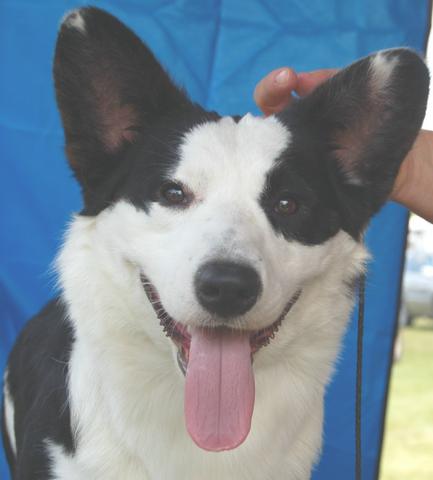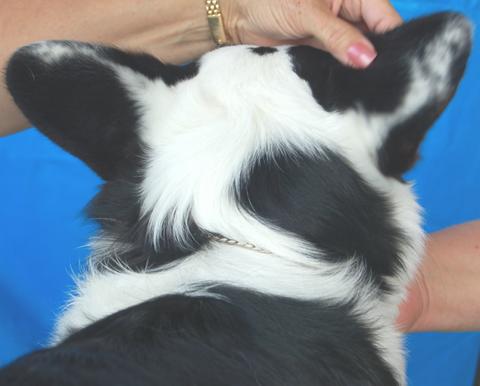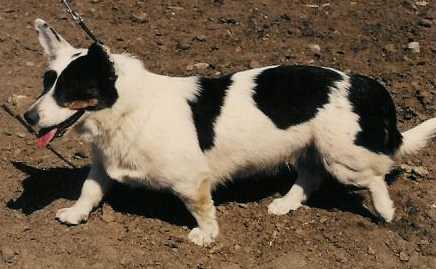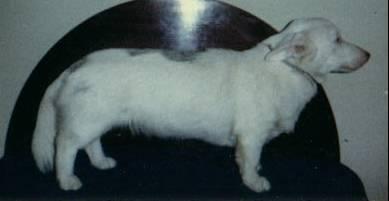|
White markings in Cardigan Welsh
Corgis
Traditional Irish Pattern white markings (blaze, collar, white
feet and tip of tail) have always been considered aesthetically
pleasing in the Cardigan Welsh Corgi. However, opinions differ
greatly when it comes to how much white is desirable both on
the head and the body. Because the wording of the standards
both in the country of origin and AKC / FCI is not that clear,
the issue of how much white is acceptable can be confusing both
for breeders and judges. By contrast, the standard for the
Pembroke Welsh Corgi is much more severe than that of the
Cardigan regarding the amount and placement of white markings,
and too many judges transfer those ideas over to Cardigans.
That is incorrect and will lead to wrong decisions.
To clarify the subject of white markings in the breed we need
to split the discussion up in two parts.
Firstly - how much white is accepted in the different breed
standards, and how does one judge variations in markings?
Secondly - how does one deal with the issue of white markings
as a breeder. How are the patterns of inheritance and how does
one base ones breeding decisions when faced with dogs that
display much white?
Clarification of the Standards:
FCI & KC Standard
The standard for the Cardigan Welsh Corgi everywhere except
the USA says
Any colour, with or without white
markings, but white
should not predominate.
The KC / FCI standard does not specify permissible markings on
the head, but does call for the eye rims to be dark.
A commentary on this breed standard (CWCA 1983 Year Book)
explained more clearly what was considered desirable: "White
may be found on the muzzle, in a blaze on the head, chest, collar, legs and
feet, tip of tail and low on the flanks. More
extensive white markings and broken patches of colour are not
encouraged."
When judging by these standards one must know when a dog is "predominantly
white". The term "predominate" means, "to be the
stronger or leading element, to appear more noticeable or
imposing than something else, to be of nor have greater quantity," etc. Put more
simply, a dog that is predominantly
white will appear to be a white dog with dark markings. The
Cardigan Welsh Corgi has never been a white dog, and this
colour is then by definition a serious breed type fault.
A judge must be able to distinguish between a dog, which is
basically white with patches of other colour, and one which is
coloured and carrying large white markings. The latter is
perfectly acceptable.
Head
When judging white markings on the head there are two
considerations that need to be made: Firstly, the breed
standard calls for dark eye rims, and so, pink eye rims due to
excessive white on the head must be viewed as a fault. Secondly, the head of the Cardigan must also be that of a
coloured dog with white markings, not a white dog with coloured
patches.
Therefore, when judging a dog with what appears to be
excessive white on the head one must consider how much this
distracts from good breed type, and fault the dog accordingly.
The KC/FCI standards does not mention white on ears or smaller
white body splashes as faults, and these should be considered
as cosmetic irregularities, as long as they do not take on such
proportions as to make the white seem predominant.
In the UK show ring of today you would hardly see a dog
carrying the type of white markings seen on some of the dogs in
the past such as Ch. Parmel Digger or Ch. Echium of Hezelclose
although the wording of the standard would not prevent such a
dog from winning.
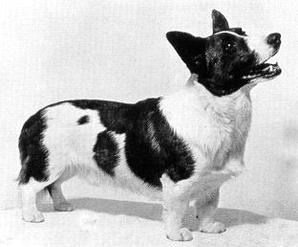
Ch. Echium of Hezelclose (born 23.7.1966) |

Ch. Parmel Digger (born 05.09.1963) |
AKC Standard:
The AKC standard says:
| All shades
of red, sable and brindle. Black with or without tan or
brindle points. Blue merle (black and gray; marbled) with
or without tan or brindle points. There is no color
preference. White flashings are usual on the neck (either
in part or as a collar), chest, legs, muzzle, underparts,
tip of tail and as a blaze on head. White on the head
should not predominate and should never surround the eyes.
Any color other than specified and/or body colors
predominantly white are disqualifications. |
The AKC standard also calls for dark eye rims.
When judging using the AKC standard one must know what is meant by
"body predominantly white" - note that the AKC standard
specifies the body of the dog, so the head should not be considered
when one is deciding whether to disqualify a dog or not due to
excessive white. As discussed in the paragraph on the KC /FCI
standard, a dog that is predominantly white is one that appears to
be a white dog with coloured markings In the AKC standard a
predominantly white body on a Cardigan is considered to be such a
serious breed type fault that it disqualifies the dog from the ring.
Secondly, one should understand the issue of white on the head.
While not an outright disqualification, nonetheless too much white
should be discouraged. Once again, a head which appears to be white
with some dark patches is not what is wanted. Note that the Cardigan
standard tolerates more white than the Pembroke.
The breed standard calls for dark eye rims, so if there are pink eye
rims due to excessive white on the head this must be considered a
fault.
Thirdly a judge must know what is meant by "white should never
surround the eyes".
The wording of the standard asks for colour to touch the eye rim, so
that white does not completely surround it. It even specifies "eyes"
in plural, which opens up for the judge to interpret this part of
the standard quite liberally. The view that colour must surround the
eyes leads to incorrect interpretation of this section of the
standard. While such an interpretation is reasonable, it could be
considered too severe - the standard only asks for colour to touch
the eye. This wording is very open to interpretation, and it must be
remembered that it still describes a breed type fault, not grounds
for disqualification. On the occasion that white does surround the
eyes, judges should treat it as a fault and view its importance
against how much it detracts from correct breed type.
The AKC standard does not mention white on ears or smaller white
body splashes as faults, and these should be considered as cosmetic
irregularities, as long as they do not take on such proportions as
to makes the white seem predominant.
While it can rightly be maintained that colour and markings are not
important in a working dog, asymmetrical markings on the head can be
quite distracting and it often seems as if the eye in the white half
of the face is smaller than the one surrounded by colour. A head
without any white, on the other hand, can appear rather dull.
Asymmetrical markings on the front legs, e.g. a "stocking"
and a "sock", not to mention a coloured front leg where
only the tips of the toes are white, can give the impression of
uneven movement in front.
How do white
markings affect soundness of the dogs,
and how should this be viewed from a breeder's perspective?
Irregular white, or a dog
whose background colour was white, was not uncommon among the early
Cardigans rescued from Welsh farms or purchased from the few
breeders who retained old stock that their ancestors had on the
farm, and used as foundation stock in the early 20th century. Thus,
irregular white might be considered part of the breed heritage.
White markings and/or spots might also have been desirable in a farm
dog because it was better visible when out working. Restrictions
from those starting points have been introduced, as far as we can
determine, mostly from aesthetic preference.
In a feature on the Cardigan breed standard, published in Dog World
on 24 September 1976, breeder judge J.E.J. Parkinson (Parmel
Cardigans) writes: "Excessive white is not favoured, especially
on the body, but the variety of colours with or without white
markings add to the appeal of the breed". In 1978 the standard
was changed from "Any colour except pure white" to "Any
colour, with our without white markings, but white should not
predominate".
In all animals species there are certain health problems that can
arise from complete lack of pigmentation, so breeders should have
some basic knowledge of the inheritance of white markings and the
role played by pigment cells in the body, when making their breeding
decisions.
24.03.2008
|
